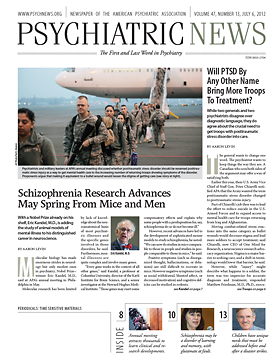Millions of children and adolescents are impacted by disasters and wars throughout the world. Over the past 10 years, since the terrorist attacks of September 11, 2001, there has been an increase in interest in the study of the psychiatric effects of disasters, including their effects on children and adolescents. The massive earthquake in Haiti in 2010 and the Pacific tsunami in 2004 caused untold tragedy and suffering for hundreds of thousands of people, many of them children. In response, the National Commission on Children and Disasters submitted its 2010 Report to the President and Congress to improve planning and services for children. (In December 2011, APA’s Board of Trustees approved a position statement endorsing the report along with the American Academy of Child and Adolescent Psychiatry.)
Children are very vulnerable due to their limited communication skills, immature cognitive abilities, and high dependency on their parents and other adults. Children are impacted by the specific nature of the disaster, their losses, and the emotional distress experienced by their parents, their teachers, and the people in their community. Vulnerability is increased for children experiencing the cumulative impact of traumas, such as children in Sri Lanka whose functioning was adversely affected by three event types: tsunami and disaster, war, and family violence.
Children and adolescents have distinct needs for preparation before a disaster, as well as during the acute and postacute phases of a disaster. Child psychiatrists—including via telepsychiatry—other mental health professionals, pediatricians, and nurses are in a unique position to meet these needs because of their understanding of child development, childhood disorders, and family dynamics.
Psychological First Aid
Psychological first aid (PFA) for children differs from that for adults in that in addition to assuring safety and securing food, water, and shelter, PFA for children involves developmentally targeted interventions. The risks of PFA may, however, outweigh the benefits by exposing children to peers with more extreme emotional responses and experiences. With proper training, such as that available online—for example, “Psychological First Aid Online” at
nctsn.org —I recommend the use of PFA with children in the early aftermath of disasters. For psychiatrists who are trained in the National Child Traumatic Stress Network course, risks may be avoided. It incorporates strategies focusing on children and families in which parents, teachers, and community resources give basic psychological support to infants, children, and adolescents. It should be adapted to the cultural and religious beliefs of those impacted. The basic goals for children include listening, protecting, connecting, modeling calm and optimistic behavior, and teaching as appropriate to their developmental phases.
Support From Schools
Interventions in schools is a major postdisaster focus in children’s services since many children can be rapidly and helpfully informed of the disaster by responsible school officials, given realistic reassurance, and screened. Parents are often overwhelmed and unable to seek services even when needed.
Specialized Treatment Postdisaster
Although most children and adolescents cope well and with resilience to the natural support systems in their community and to PFA, a minority require more specialized mental health treatment for grief, PTSD, or depression, many via telepsychiatry consultation to primary care. Psychopharmacological interventions have a very limited place due to the effectiveness of psychological interventions, the inability to follow patients who are on medications, and the lack of enough evidence for medications preventing PTSD. However, our group, in studying children with burn injuries, found preliminary evidence for morphine prevention of PTSD symptoms and possible efficacy for sertraline as well. Generally, postdisaster psychopharmacological treatment involves prescribing previous medications to prevent relapse.
Goenjian and colleagues, in the American Journal of Psychiatry in 1997, described how, whenever possible, those with continued evidence of distress should be enrolled in a structured, culturally informed, brief, crisis-intervention-focused supportive psychotherapy for one to six sessions. The focus is on psychoeducation, relaxation exercises, cognitive reframing, coping mechanisms including distraction, physical and social activities, and problem solving.
A randomized study by Catani and colleagues, published in Child Development in 2010, compared meditation and relaxation with a narrative exposure therapy in Sri Lanka. During the first months after the tsunami, brief six-session treatment was effective in both treatment groups. This study is noteworthy since it targeted a heavily traumatized population secondary to the civil war and other disasters. Sri Lanka’s population is also culturally distinct from many of the populations studied previously. It is imperative that planned mental health interventions are culturally and religiously informed.
In summary, preparation is the key to meeting the postdisaster needs of children, families, and schools. Pediatric services, other child services, and schools should have specific plans and staff-disaster training to anticipate and meet the mental health needs of children and staff, and they should coordinate their planning with other disaster agencies. Children’s mental health needs range from support such as using PFA for acute conditions like acute distress and acute grief to psychotherapeutic treatment of disorders that may persist such as PTSD or depression, which require ongoing evaluation and treatment. Psychopharmacological treatment may be indicated where monitoring and follow-up are possible, including via telepsychiatry.
Effective preparation, including staff training, may mitigate the impact of disaster trauma for infants, children, adolescents, and their families.

Frederick J. Stoddard Jr., M.D., is an associate clinical professor of psychiatry at Harvard Medical School at the Massachusetts General Hospital. He is editor, with Anand Pandya, M.D., and Craig Katz, M.D., of Disaster Psychiatry: Readiness, Evaluation, and Treatment from American Psychiatric Publishing. The book may be ordered online at www.appi.org/SearchCenter/Pages/Search Detail.aspx?ItemId=7217. APA members can purchase the book at a discount. 
